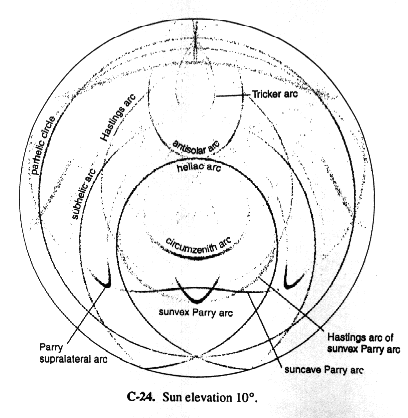- Crystal orientation:
- double orientation
- Path of light:
- Reflection at the prism face 5 and 7
- Occurrence:
- very rarely
EE 61

Description:
A heliac arc forms a loop above the sun. At a sun elevation of 10° this loop even passes the zenith. With increasing sun elevations this loop shrinks more and more, When the sun reaches an elevation of 30° ‚ the vertex of the loop is situated just above the circumzenithal arc. Simultaneously the two ends of the arc which are beneath sun elevation sweep more and more to the east respectively to the west. At a sun elevation of 50° the loop above the sun has become so small that its vertex becomes situated lower than the Party arc. At a sun elevation of 65° the two ends meet opposite the sun on the horizon. In Central Europe this halo has been observed at very few occasions only. There are several reasons for that it appears so seldom. First there has to be a large number of double-orientated column-shaped ice crystals, a thing that happens very seldom. Further more, this arc is very faint and white. So it does not stand out well from the sky behind it. Good conditions exist when the sky is covered with a thin, hardly visible cirrostratus layer. When there is a well-developed Party arc visible, you can also reckon with the appearing of a heliac arc.

Simulation of halos which are caused by double orientated column-shaped ice crystals.
The Heliac arc is the big loop above the sun. Grafik: W. Tape, Atmospheric Halos, S. 117, Am. Geophys. Union 1994
Formation:
A heliac arc is mainly caused by reflection of sunlight from the two prism faces which are situated on the lower prism face of the crystal. Its formation can be compared to that of the parhelic circle. But in case of the heliac arc the faces of the crystals are not orientated vertically but at an angle of 60° to the horizon. Not only external reflection from the surface, but also internal reflection inside the crystal contributes to this halo. Hereby the refractions when the light enters and leaves the crystal cancel each other in such a way that the light does not get split into its spectral colours.


